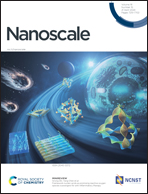EuIII and TbIII upconversion intermediated by interparticle energy transfer in functionalized NaLnF4 nanoparticles†
Abstract
Lanthanide (LnIII)-doped sodium gadolinium tetrafluoride (NaGdF4) nanoparticles have been excelled as attractive upconversion systems for anti-counterfeiting or energy conversion for instance, with a special interest in the visible upconversion of EuIII and TbIII. The core@shell architecture has enabled the bright upconversion of EuIII and TbIII in this matrix by interfacial energy transfer sensibilized by the TmIII/YbIII pair. Another approach to enable EuIII and TbIII upconversion could be the interparticle energy transfer (IPET) between LnIII-doped sensitizer and acceptor nanoparticles. Yet, the low molar absorptivity of the LnIII through 4f ↔ 4f electronic transitions and the large distance between the nanoparticles are shortcomings that should decrease the energy transfer efficiency. On the other hand, it is feasible to predict that the association of organic ligands displaying large molar absorptivity on the acceptor nanoparticle surface could help to overcome the absorption limitation. Inspired by this exciting possibility, herein, we present the EuIII/TbIII upconversion intermediated by IPET between the donor TmIII, YbIII-doped NaGdF4 nanoparticle and the acceptor LnIII-doped NaGdF4 (Ln = Eu and/or Tb) nanoparticles functionalized with a series organic ligands on the surface (tta− = thenoyltrifluoroacetonate, acac− = acetylacetonate, or 3,5-bbza− = 3,5-dibromebenzoate). Either in solid state or in suspension, upon excitation at 980 nm, visible EuIII/TbIII upconversion could be observed. This emission comes from the absorption of the TmIII, YbIII pair in the donor nanoparticle, followed by IPET from the TmIII excited levels to the ligand singlet/triplet states on the acceptor nanoparticle surface, ligand-to-EuIII/TbIII energy transfer, and upconversion emission. Spectroscopic evidences from the analysis of the donor level lifetimes indicate the contribution of non-radiative energy transfer for the IPET mechanism; the radiative mechanism also contributes for the IPET. Moreover, the design herein introduced enables the development of luminescence temperature probes with relative thermal sensitivity as high as 1.67% K−1 at 373 K. Therefore, this new upconversion pathway opens an avenue of possibilities in an uncharted territory to tune the visible upconversion of LnIII ions.



 Please wait while we load your content...
Please wait while we load your content...